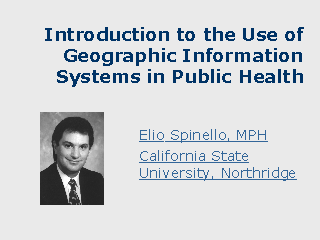| front |1 |2 |3 |4 |5 |6 |7
|8 |9 |10 |11 |12 |13 |14 |15 |16 |17 |18 |19 |20 |21 |22 |23 |24 |25 |review |
 |
The technological
advancement of GIS (Geographic Information System) technology has provided the field of
public health, and particularly epidemiology with an important tool making analysis
possible that was once technologically out of reach. In the field of public health, GIS systems have provided a means to analyze data from a much more sophisticated perspective. In addition to being able to assess disease cases with a general categorical definition of "place", GIS systems have provided the means to analyze spatial/temporal relationships between sets of variables, allowed users to identify spatial patterns in data, and have provided the means to integrate databases on the basis of geography. I have taught computer applications to students in clinical and public health programs for a number of years and have been personally fascinated by the rapid technological development in two areas with respect to their impact on public health – the Internet and Geographic Information Systems. These areas have provided solutions to public health problems that had previously been approached in much less sophisticated fashion or had been largely ignored. This has been particularly true in the area of public health needs assessment – an area in which the application of GIS technology makes it possible to specifically locate and profile a target population to a degree never previously possible without primary research. Although the need for primary research will never leave us, GIS technology allows the researcher to apply it more specifically, saving both time and cost. |